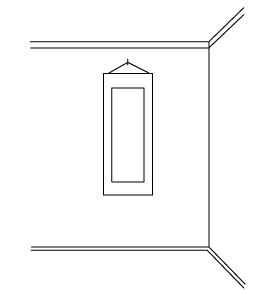|
||
 |
||

(C)2001 Japanese Architecture and Art Net Users System. No reproduction or republication without written permission.
掲載のテキスト・写真・イラストなど、全てのコンテンツの無断複製・転載を禁じます。
|
||||||
| kabedoko 壁床 | ||||||
| KEY WORD : architecture / tea houses | ||||||
| A wall alcove. An alcove that has no recessed space and no appurtenances
such as a framing board *tokogamachi
床框, a top facing board *otoshigake
落掛, or any type of demarkation denoting an area set off from the main part
of the room. There is only a hook in the wall for hanging a scroll. In some
large rooms, only a regular mat size baseboard is placed against the wall
to serve as the kabedoko. The oldest existing kabedoko is
thought to be an 18cm alcove in a *shoin
書院 style built at the Shouden-in 正伝院 a branch of Kenninji 建仁寺 in Kyoto,
by Oda Uraku 織田有楽 (1547-1621). The kabedoko differs from the *oribedoko
織部床 created by Furuta Oribe 古田織部 (1543-1615) in that the latter has a smoothly
planed board about 20cm wide, or a length of bamboo, set between posts attached
to the wall just below the ceiling, for mounting the scroll hook. The kabedoko
is said to be the earliest type of alcove and thought to be a forerunner
of the *tokonoma
床の間. The kabedoko style of alcove was greatly favored from the time
of Sen Rikyuu 千利休 (1522-91) to the time of Sen Soutan 千宗旦 (1578-1659). According
to the SUKIYA KOUHOUSHUU 数寄屋工法集, "The alcove called a wall alcove
was favored by Rikyuu and it should be pointed out that when Soutan had
the Konnichi'an 今日庵 built, he also used a wall alcove." |
||||||
 |
||||||
| REFERENCES: | ||||||
| *tsuridoko 釣床 | ||||||
| EXTERNAL LINKS: | ||||||
| NOTES: | ||||||
(C)2001 Japanese Architecture and Art Net Users System. No reproduction or republication without written permission. 掲載のテキスト・写真・イラストなど、全てのコンテンツの無断複製・転載を禁じます。 |
||||||